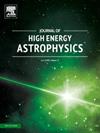Power law cosmology in Gauss-Bonnet gravity with pragmatic analysis
IF 10.2
4区 物理与天体物理
Q1 ASTRONOMY & ASTROPHYSICS
引用次数: 0
Abstract
In this study, we present an approach gravity incorporating power law in G. To study the cosmic evolution of the universe given by the reconstruction of the Hubble parameter given by . Subsequently, we use various recent observational datasets of OHD, Pantheon, and BAO to estimate the model parameters , and β applying the Markov Chain Monte Carlo (MCMC) technique in the emcee package to establish the validity of the model. In our findings, we observe that our model shows consistency with standard ΛCDM, transits from deceleration to acceleration, and enters the quintessence region in late times. The cosmological model satisfies necessary energy constraints, simultaneously violating the strong energy condition (SEC), indicating a repulsive nature and consistent with accelerated expansion. The cosmic evolution of the Hawking temperature and the total entropy for the various observational datasets also show the validity of the model. Thus, our established model demonstrates sufficient potential for explicitly describing cosmological models.
高斯-邦尼引力中的幂律宇宙论及其实用分析
在本研究中,我们提出了一种包含幂定律的f(R,G)引力方法,研究了E(z)=(1+z(α+(1+z)β)2β+1)32β给出的哈勃参数的重建所给出的宇宙演化。随后,我们使用OHD, Pantheon和BAO的各种近期观测数据集,应用emcee软件包中的马尔可夫链蒙特卡罗(MCMC)技术估计模型参数H0,α和β,以验证模型的有效性。在我们的研究结果中,我们观察到我们的模型与标准ΛCDM一致,从减速过渡到加速,并在后期进入精华区域。宇宙学模型满足必要的能量约束,同时违反强能量条件(SEC),表明斥力性质,与加速膨胀相一致。各种观测数据集的霍金温度和总熵的宇宙演化也证明了该模型的有效性。因此,我们建立的模型显示了明确描述宇宙模型的足够潜力。
本文章由计算机程序翻译,如有差异,请以英文原文为准。
求助全文
约1分钟内获得全文
求助全文
来源期刊

Journal of High Energy Astrophysics
Earth and Planetary Sciences-Space and Planetary Science
CiteScore
9.70
自引率
5.30%
发文量
38
审稿时长
65 days
期刊介绍:
The journal welcomes manuscripts on theoretical models, simulations, and observations of highly energetic astrophysical objects both in our Galaxy and beyond. Among those, black holes at all scales, neutron stars, pulsars and their nebula, binaries, novae and supernovae, their remnants, active galaxies, and clusters are just a few examples. The journal will consider research across the whole electromagnetic spectrum, as well as research using various messengers, such as gravitational waves or neutrinos. Effects of high-energy phenomena on cosmology and star-formation, results from dedicated surveys expanding the knowledge of extreme environments, and astrophysical implications of dark matter are also welcomed topics.
 求助内容:
求助内容: 应助结果提醒方式:
应助结果提醒方式:


